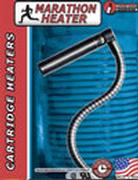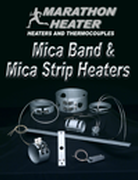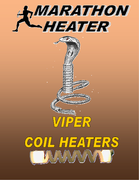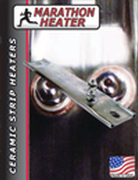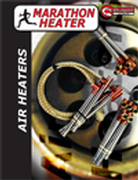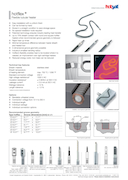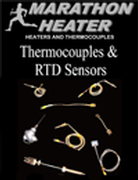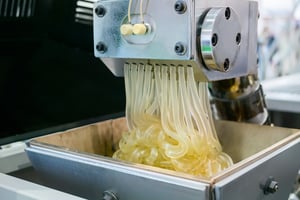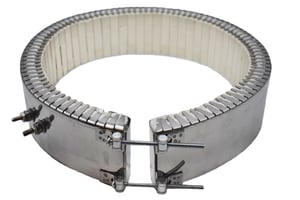Selecting the Right Process Heater When Working with Plastics and Rubber Temperature Control...
Exploring Heater Applications in the Plastics and Packaging Industries
Specific Applications of Heaters for Plastics and Packaging OEMs
The plastics and packaging industry is a cornerstone of modern manufacturing, producing everything from everyday consumer goods to specialized industrial components. At the heart of many processes within this industry are electrical process heaters, which play a critical role in shaping, forming, and maintaining the integrity of plastic products. From ensuring precise temperature control in injection molding machines to providing consistent heat in packaging sealers, heaters are indispensable.
This blog delves into the various types of heaters used in the plastics and packaging sector, exploring their specific applications, benefits, and how they contribute to the efficiency and quality of production. Whether you are a seasoned industry professional or new to the field, understanding these heater applications can provide valuable insights into optimizing your manufacturing processes.
Mica Band Heater Applications in Plastics and Packaging Industries
Mica band heaters are commonly used in the plastics and packaging industries due to their efficient heat transfer and ability to maintain high temperatures. Here are some specific applications:
Injection Molding Machines
Mica band heaters are used to heat the barrels of injection molding machines. This ensures the plastic pellets melt uniformly before being injected into the mold.
Extrusion Equipment
In plastic extrusion processes, mica band heaters maintain the required temperatures along the extruder barrels to ensure consistent melting and mixing of plastic materials. They can also be used on die heads and adaptors, giving a boost of heat to areas at nearly any part of the process.
Blow Molding Machines
These heaters are used to heat the plastic parison (a tube of molten plastic) to the proper temperature before it is inflated into the desired shape.
Plastic Welding and Sealing
Mica band heaters provide localized heating for plastic welding and sealing applications, ensuring strong and uniform welds.
Plastic Pipe and Profile Production
In the production of plastic pipes and profiles, these heaters maintain the necessary temperatures in the forming and shaping equipment.
Packaging Machinery
Mica band heaters can be employed in packaging machinery to maintain the temperature of sealing bars, ensuring proper sealing of plastic films and bags.
3D Printing
In some advanced 3D printing applications, mica band heaters are used to maintain the temperature of the print heads or the printing material reservoirs.
The key advantages of mica band heaters in these applications include their ability to provide uniform heating, their durability in high-temperature environments, and their relatively quick response time in reaching and maintaining the desired temperatures.
Ceramic Band Heater Applications in Plastics and Packaging Industries
Ceramic band heaters are highly efficient and durable, making them ideal for various applications in the plastics and packaging industries. Here are some specific applications:
applications in the plastics and packaging industries. Here are some specific applications:
Injection Molding Machines
Ceramic band heaters are used to heat the barrels of injection molding machines. They provide consistent and precise heating, ensuring the plastic pellets melt uniformly before being injected into the mold. Ceramic band heaters provide one of the highest energy efficiency options, as well, due to their construction and the materials used.
Extrusion Machines
In plastic extrusion processes, ceramic band heaters maintain the required temperatures along the extruder barrels. Their ability to deliver high temperatures with excellent heat distribution ensures consistent melting and mixing of plastic materials. Ceramic heaters work best in clean processes. If there is significant presence of contamination, a facility will want to use a different style of heater that is more enclosed and resistant to intrusion.
Blow Molding Equipment
Ceramic band heaters are used to heat the barrel in blow molding machines to the correct temperature before it reaches the die head. They can also be used to heat the outer surface of the die head itself, but often due the number of obstructions (thermocouples, bolts, etc.), other heater styles are preferred for the die head. This prepares the material for the mold.
Blown Film Extrusion
In blown film extrusion processes, ceramic band heaters help maintain the temperature of the extruder barrels. They are also used on the die head that directs the plastic upward. Experts tip: Given the nature of a tiled ceramic heater, most users will specify a spring-tensioned mounting bolt to ensure the heater always stays slightly in tension and doesn’t “sag” on the vertical tie head. Ask for a spring-loaded clamp style.
Plastic Pipe and Profile Extrusion
These heaters maintain the necessary temperatures in the forming and shaping equipment used in the production of plastic pipes and profiles, ensuring uniformity and quality.
Recycling Equipment
Ceramic band heaters are used in plastic recycling equipment to maintain the necessary temperatures for melting and reprocessing plastic waste, ensuring efficient and consistent recycling operations. These heaters, however, perform the best in clean, contamination-free environments, so you’ll want to consider this when reviewing whether ceramic band heaters are right for the application.
Packaging Machinery
In packaging machinery, ceramic band heaters can be used to maintain the temperature of sealing bars, ensuring proper sealing of plastic films and bags. They provide reliable and consistent heat, essential for high-speed and high-quality packaging operations.
The key advantages of ceramic band heaters in these applications include their ability to provide high temperatures with excellent heat retention and energy efficiency. Their robust construction allows them to withstand frequent cycling and prolonged use, making them ideal for demanding applications in the plastics and packaging industries. If improving energy efficiency is a plant goal, the ceramic band heater is an excellent option.
Cartridge Heater Applications in Plastics and Packaging Industries
Cartridge heaters are versatile and efficient heating elements widely used in the plastics and packaging industries. Here are some specific applications:
packaging industries. Here are some specific applications:
Injection Molding
Nozzle Heating: Cartridge heaters are used to maintain the temperature of the nozzles in injection molding machines, ensuring consistent flow and preventing the plastic from solidifying before injection.
Manifold Heating: They can also be used in hot runner systems to keep the manifold at the required temperature, ensuring uniform distribution of molten plastic to the molds.
Thermoset Process Heating: Cartridge heaters are used as the final heating step for most thermoset molding processes. They provide immediate and precise heating to the mold and can even be provided in distributed wattage to direct more resistance to the outsides of the mold, which compensates for heat sink that often happens in those areas of the mold.
Extrusion
Barrel Heating: Often, designs call out multiple cartridge heaters per barrel zone along an extrusion process. This will often be used in twin screw-style extruders that processors will use to mix and process polymers, a wide range of fillers, and even foods.
Die Heating: In extrusion processes, cartridge heaters maintain the temperature of the extrusion die, ensuring consistent melting and flow of plastic.
Pelletizer Heating: Cartridge heaters are a mainstay in many styles of pelletizing, including underwater pelletizing systems. They provide uniform heat around the outer surface of the pelletizer dies and rings.
Blow Molding
Preform Heating: Cartridge heaters are used to heat the preform molds in blow molding machines, ensuring the plastic preforms are at the right temperature for blowing into final shapes.
Thermoforming
Heating Platens: In thermoforming applications, cartridge heaters can be used to heat the platens that press the plastic sheets into molds, ensuring even heating and forming. These are often used along a vacuum system that softens the material before being pulled into the mold and final forming is completed.
Screen Changers: Filtering the melt at the end of any extrusion process is an important step. Cartridge heaters offer a wide range of versatility with how they can be used to heat various screen changer systems. They maximize the power applied to these critical systems to ensure flow is not slowed.
Melt Pumps: Some processes involve the use of these systems to more precisely control the output of the dies. These systems require a critical balance of suction and discharge, so cartridge heaters provide a critical targeted heating source to ensure the polymer stays at the intended viscosity as it passes through the pump.
Plastic Welding and Sealing
Welding Tools: Cartridge heaters are used in plastic welding tools to provide localized heat for creating strong, uniform welds.
Heat Sealing: They are used in heat sealing machines to maintain the temperature of sealing bars, ensuring proper sealing of plastic films and bags. Expert Tip: Often there will be a high level of motion in these sealing bar systems. You’ll want to consider a lead wire exit style that performs well in a high motion, cycling environment. Motion will ultimately drive the life span of a heater, but with the right adjustments, heater lives can be doubled and tripled by anticipating this motion.
Hot Stamping and Embossing
Stamping Dies: Cartridge heaters are used to heat stamping dies in hot stamping and embossing processes, allowing for precise and consistent transfer of designs onto plastic surfaces.
Labeling Machines
Label Applicators: Cartridge heaters are used in labeling machines to ensure that the adhesive used for labels is at the correct temperature, facilitating smooth and effective label application.
Blown Film Extrusion
Die Head Heating: In blown film extrusion, cartridge heaters maintain the temperature of the die head, ensuring consistent film thickness and quality.
Plastic Pipe and Profile Extrusion
Forming Tools: They can be used to heat forming tools and dies in the extrusion process, ensuring uniform shaping of plastic pipes and profiles.
Packaging Machinery
Form-Fill-Seal Machines: Cartridge heaters are used in form-fill-seal machines to maintain the temperature of sealing elements, ensuring strong and reliable seals for plastic packaging. Often, they are used as the interchangeable heating element of a pre-constructed banded system or manifold.
Shrink Wrapping: They are used in shrink wrapping machines to maintain the correct temperature for shrinking plastic film around products, ensuring tight and secure packaging.
3D Printing
Print Heads: Cartridge heaters are used in 3D printers to heat the print heads or nozzles, ensuring consistent extrusion of printing material and high-quality prints.
Recycling Equipment
Melting Units: In plastic recycling, cartridge heaters are used in melting units to maintain the temperature required to reprocess plastic waste efficiently.
Cartridge heaters are favored in these applications for their high watt density, rapid heating capabilities, precise temperature control, and ability to fit into small spaces. Their robust construction allows them to withstand harsh operating conditions and frequent cycling, making them ideal for demanding environments in the plastics and packaging industries.
Starflex Band Heater Applications in Plastics and Packaging Industries
Starflex band heaters are specialized heating elements designed for the plastics and packaging industries. They are known for their durability, flexibility, and efficiency in providing consistent and uniform heat. We discuss some specific applications where Starflex band heaters are commonly used.
packaging industries. They are known for their durability, flexibility, and efficiency in providing consistent and uniform heat. We discuss some specific applications where Starflex band heaters are commonly used.
Injection Molding
Barrel Heating: Starflex band heaters are used to maintain the temperature of the barrels in injection molding machines, ensuring the plastic material is melted and kept at the optimal temperature for injection.
Nozzle Heating: They are also used to heat the nozzles to prevent the plastic from solidifying before it is injected into the mold.
Thermoset Barrels: Often, facilities will cool the barrels as part of the curing process as material heads to the mold. The Starflex has a unique design option that allows not only heating, but also heating AND cooling, or cooling only. It’s a great option for thermoset processing facilities.
Extrusion
Extruder Barrel Heating: In extrusion processes, Starflex band heaters provide uniform heating along the length of the extruder barrel, facilitating the consistent melting and flow of plastic materials. Expert Tip: We spoke above of the ceramic heaters operating best in clean conditions. The Starflex would be preferred at the opposite end of the spectrum. That is—in conditions that have a high level of contamination, whether that be dirt, talc, and even some levels of moisture. The Starflex is your high-durability option in rugged applications,
Die Heating: They maintain the temperature of extrusion dies, ensuring the plastic is properly shaped and formed as it exits the extruder.
Blow Molding
Mold Heating: They provide consistent and reliable heat to the molds, ensuring uniform wall thickness and high-quality final products.
Plastic Welding and Sealing
Welding Tools: Starflex band heaters can be used in plastic welding tools to provide localized and precise heating for creating strong, uniform welds.
Heat Sealing: They are used in heat sealing machines to maintain the temperature of sealing bars, ensuring proper sealing of plastic films and bags.
Extrusion Blow Molding
Blow Mold Heating: In extrusion blow molding, Starflex band heaters maintain the temperature the barrels, ensuring uniform mixing and preparation of the polymers before heading to the die head and molds.
Plastic Pipe and Profile Extrusion
Die Heating: They are used to heat the extrusion dies, ensuring consistent and precise shaping of plastic pipes and profiles. Note: There is also a Starflex style, flat strip heater that can be mounted to the top and sides of your square or rectangular die heads. These come with mounting holes designed in to allow for the use of mounting bolts and washers to secure the heaters.
Forming Tools: Starflex band heaters provide uniform heat to forming tools, facilitating the production of high-quality plastic products.
Blown Film Extrusion
Die Head Heating: Starflex band heaters maintain the temperature of die heads in blown film extrusion, ensuring consistent film thickness and quality.
Air Ring Heating: They are used to heat air rings, helping to control the cooling and solidification of the film. Expert Tip: Consider the use of spring-tensioned mounting screws as part of your design. These are often vertical installations, and between cycling (heating to cooling), the heaters have a tendency to sag—and when contact is not consistent, it can lead to overheating and heater failure. Overcome this by keeping gentle tension on the heater always; keep it snug to the air ring/vertical die head.
Packaging Machinery
Form-Fill-Seal Machines: Starflex band heaters can be used to maintain the temperature of sealing elements in form-fill-seal machines, ensuring strong and reliable seals for plastic packaging.
Shrink Wrapping: They are used in shrink wrapping machines to maintain the correct temperature for shrinking plastic film around products, ensuring tight and secure packaging.
Recycling Equipment
Melting Units: In plastic recycling processes, Starflex band heaters are used in melting units to maintain the temperature required to reprocess plastic waste efficiently.
Starflex band heaters are preferred in these applications for their excellent heat transfer capabilities, flexibility to fit various shapes and sizes, and durability to withstand the demanding conditions of the plastics and packaging industries. Their ability to provide uniform and controlled heating ensures high-quality production and efficient operation.
Thermocouples Applications in Plastics and Packaging Industries
Thermocouples are essential temperature sensing devices used extensively in the plastics and packaging industries due to their reliability, accuracy, and ability to measure a wide range of temperatures. Here are some specific applications:
packaging industries due to their reliability, accuracy, and ability to measure a wide range of temperatures. Here are some specific applications:
1) Injection Molding
Mold Temperature Control: Thermocouples monitor the temperature of molds to ensure that the plastic is injected and solidified under optimal conditions, improving product quality and reducing defects. Two primary styles of thermocouples are used here: surface mount, which are affixed near the outer edges of the mold and detect the surface temperatures of the mold; and mineral insulated style thermocouples that are connected to the internal nozzles, often as part of a hot runner style system.
Learn more about general-purpose mineral insulated thermocouples.

Barrel Temperature Monitoring: They are used to measure the temperature of the barrel heaters and affix to the surface of the barrel zones themselves, or can even be integrated into the heaters themselves.
Nozzle Temperature Monitoring: Although these serve the same function as the barrel thermocouples, nozzle thermocouples come in a wider range of options, including two that are built to suit common OEM styles. These are the Nissei style and Newbury nozzle style thermocouples. Another of the most common types of nozzle sensors is the shallow nozzle style, which comes in the very common ¼-28NF thread. If you need a solid universal, no-frills option, some use a shim style thermocouple that is a thin stainless-steel patch that users slide under the heater and will relay the surface temperature.
thermocouples. Another of the most common types of nozzle sensors is the shallow nozzle style, which comes in the very common ¼-28NF thread. If you need a solid universal, no-frills option, some use a shim style thermocouple that is a thin stainless-steel patch that users slide under the heater and will relay the surface temperature.
2) Extrusion
Extruder Barrel Temperature Control: Thermocouples are placed along the length of the extruder barrel to maintain precise temperature profiles, ensuring consistent melting and flow of plastic materials. Often these thermocouples are connected to each zone along the extruder barrel and can allow different areas to be set to different temperatures, depending on the formulas being used.
Die Temperature Monitoring: They measure the temperature of extrusion dies to ensure the plastic is formed correctly as it exits the extruder.
Pelletizers: Thermocouples are an important—not to be overlooked—part of an effective pelletizing process. This is the critical end of the process part where the process heating and melt temperature need to stay in the sweet spot before being pelletized.
In Melt Thermocouples: Similar to the above discussion, there are two main ways to monitor and use temperature sensors. One monitors the surface temperatures. Often, these thermocouples are affixed to a threaded hole in the “metal” itself. The controller is set to make this estimate of how the process material is performing based on this calculation. In other applications, such as compounding, blown film, or even food, a deeper level of precision is desired. In these applications, a processor will use an “in melt” thermocouple (also known as fixed bolt thermocouples), which, as the name indicates, actually extends into the melt flow and provides feedback of that direct process temperature. A step further, there are in melt thermocouples that can be adjusted and measure temperature with a flush tip that can be inserted further into the melt, or process, to provide the highest accuracy level of feedback to how the process is performing.
Learn more about fixed melt bolt thermocouples.
Learn more about retractable melt bolt thermocouples.
3) Blow Molding
Mold Temperature Regulation: Thermocouples are used to control the temperature of blow molds, ensuring the plastic expands uniformly to form high-quality hollow products such as bottles and containers.
Preform Temperature Control: In injection blow molding, they monitor the temperature of preforms before they are blown into final shapes.
4) Thermoforming
Heating Element Temperature Monitoring: Thermocouples are used to control the temperature of heating elements that soften plastic sheets before they are formed into products. These processes often hit higher temperatures, so you will want to consider a type K style thermocouple that performs well at high temperatures.
Mold Temperature Control: They ensure that molds are at the correct temperature to shape the plastic accurately during the thermoforming process.
5) Plastic Welding and Sealing
Welding Tool Temperature Control: Thermocouples monitor the surface temperature of plastic welding tools to ensure proper fusing of plastic parts.
Heat Sealing: They control the temperature of sealing bars in heat sealing machines to ensure strong and consistent seals in plastic packaging. Expert Tip: As discussed with heaters above, you’ll want to consider the amount of motion in each process. Thermocouples can also be designed to perform better with a higher level of motion. Please always let your engineering contacts know if motion may be a factor!
6) Blown Film Extrusion
Die Head Temperature Monitoring: Thermocouples are used to maintain the temperature of die heads in blown film extrusion, ensuring consistent film thickness and quality. As mentioned above, blown film, with the sensitivity of the material and process, often utilize the in melt style thermocouples. If you are not using one, they can be added through ½-20UNF (common thread) hole tapping kits to get access to the melt processing area.
7) Recycling
Temperature Control in Melting Units: Thermocouples are used in plastic recycling processes to monitor and control the temperature of melting units, ensuring efficient reprocessing of plastic waste.
8) 3D Printing
Print Head Temperature Monitoring: Thermocouples are used in 3D printers to measure and control the temperature of print heads or nozzles, ensuring consistent extrusion of printing material.
9) Packaging Machinery
Form-Fill-Seal Machines: Thermocouples monitor and control the temperature of sealing elements in form-fill-seal machines, ensuring reliable seals for plastic packaging.
Shrink Wrapping: They are used to control the temperature in shrink wrapping machines, ensuring the plastic film shrinks tightly around products.
10) Material Processing and Compounding
Mixer Temperature Control: Thermocouples monitor the temperature in mixers used for compounding plastic materials, ensuring uniform mixing and preventing degradation.
Calender Roll Temperature Monitoring: In calendering processes, they measure the temperature of rolls to ensure consistent thickness and quality of plastic sheets.
11) Testing and Quality Control
Thermal Analysis: Thermocouples are used in various thermal analysis techniques to characterize the thermal properties of plastic materials, such as melting point, glass transition temperature, and thermal stability.
Environmental Chambers: They monitor temperature in environmental chambers used for testing the durability and performance of plastic products under different temperature conditions.
Thermocouples play a critical role in these applications by providing accurate and real-time temperature measurements, which are essential for maintaining process control, ensuring product quality, and optimizing production efficiency in the plastics and packaging industries.
Why Backer Marathon
Backer Marathon is the industry leader in production speed, and reliable, quality heaters for plastics and packaging, serving OEMs with durable, customized solutions for unique heating needs since 1996. We design, manufacture, and stock industrial-grade heating elements and temperature sensors. Engineers have live, on-demand access via phone to our trained technical experts who have been pioneers in this sector for decades.
How can Backer Marathon’s experts help you today? Nosotros hablamos español. Contact us today to discuss your next project.
